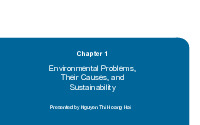



















Preview text:
ENVIRONMENTAL SCIENCE REPORT NUCLEAR POWER THE ENERGY FOR A NEW VIETNAM Group: PUTIN INTRODUCTION
Fossil fuel has been the motivation of economies for around 150 years, and
currently accounting for 80% of the world energy supply.
As we all acknowledged that Fossil fuel brings alarming environmental problems
and highly unstable, the world has been searching for multiple replacements
which are greener, less toxic, higher efficiency.
Spotting this knot, we, group PUTIN decides to initiate research with the goal is to
prove why Nuclear Energy would be the most optimal option in long term for our homeland- Vietnam. THE OUTLINE I. Fossil fuel
II. Replacements for Fossil fuel III. Local survey
IV. Understanding Nuclear energy
V. Why would nuclear energy be suitable for Vietnam VI. References: I. FOSSIL FUEL: 1. Definition:
Any of a class of hydrocarbon-containing compounds of biological origin found within the Earth’s crust
that may be utilized as a source of energy is referred to as a fossil fuel.
Coal, petroleum, natural gas, oil shales, bitumens, tar sands, and heavy oils are examples of fossil fuels. 2. Advantages:
The advantages of fossil fuel use are mostly attributed to the convenience and ease of using
wellestablished energy methods. Despite their convenience, the continued use of fossil fuels is leading to
negative environmental impacts. Well-developed
The technology we use to harness the energy in fossil fuels, such as oil rigs and drilling equipment, is welldeveloped.
The main reason for this is that fossil fuels have been used to power our world for many decades. This
makes it easy for utility companies and the energy sector to rely on old versions of energy like fossil fuels
instead of innovating to be more efficient.
Affordable and reliable
Fossil fuels have such a low cost because they are heavily subsidized by the government, and are a reliable
(as in, not intermittent like solar and wind power) source of energy.
They are deemed reliable because they can be burned day or night and they are not hindered by weather
patterns that power renewable resources, like wind and sun. However, “cheap” is a loaded term since fossil
fuels are only “cheap” because of subsidies. 3. Disadvantages: (Insert picture and graphic)
Contribute to climate change
Fossil fuels are the main driver of global warming. When they are burned, they release vast amounts of
harmful byproducts called greenhouse gases (especially carbon dioxide (CO2)), into the atmosphere.
CO2 traps an unnatural amount of heat into the atmosphere which leads to changing weather patterns,
such as hotter temperatures, more droughts, more erratic rainfall, and an overall less hospitable planet. Non-renewable
Fossil fuels are non-renewable sources of energy - unlike solar power, geothermal, and wind energy.
This means that there are finite resources available and its reserves are not replenished naturally. While
fossil fuels are made up of decomposed organic matter, like dead plants and animals, they take millions of years to form.
And unlike their renewable counterparts, they cause pollution when burned for energy. Accident-prone
Fossil fuels have led to extreme accidents over the years, including pipeline leaks, exploding drilling
platforms, and the dumping of millions of gallons of oil into the ocean. Fossil fuels will continue to pollute
the planet as long as they are in use.
Although fossil fuels have been meeting the world’s energy demands for many years, it does not mean that
we should continue to use them as our main energy resource.
Alternative sources of energy are becoming cheaper and more reliable and have the added benefit of not
emitting CO2 while they power our lives.
II. REPLACEMENTS FOR FOSSIL FUEL: 1. SOLAR ENERGY A. Definition
Solar power is energy from the sun that is converted into thermal or electrical
energy. Solar energy is the cleanest and most abundant renewable energy source
available. The U.S. has some of the richest solar resources in the world. Solar
technologies can harness this energy for various uses, including generating
electricity, providing light or a comfortable interior environment, and heating water
for domestic, commercial, or industrial use. B. Solar technology
There are three main ways to harness solar energy:
+ Photovoltaics is a form of active solar technology discovered in 1839 by 19year-
old French physicist Alexandre-Edmond Becquerel. Becquerel discovered that when
he placed silver chloride in an acidic solution and exposed it to sunlight, the
platinum electrodes attached generated an electric current. This process of
generating electricity directly from solar radiation is called the photovoltaic effect, or photovoltaics.
Today, photovoltaics is the most familiar way to harness solar energy.
Photovoltaic arrays usually involve solar panels, a collection of dozens or even hundreds of solar cells.
Each solar cell contains a semiconductor, usually made of silicon. When the
semiconductor absorbs sunlight, it knocks electrons loose. An electrical field directs
these loose electrons into an electric current, flowing in one direction—metal
contacts at the top and bottom of a solar cell direct that current to an external
object. The external object can be as small as a solar-powered calculator or as large as a power station.
+ Another type of active solar technology is concentrated solar energy or
concentrated solar power (CSP). CSP technology uses lenses and mirrors to focus
(concentrate) sunlight from a large area into a much smaller area. This intense area
of radiation heats a fluid, which in turn generates electricity or fuels another process.
Solar furnaces are an example of concentrated solar power. There are many
different solar furnaces, including solar power towers, parabolic troughs, and
Fresnel reflectors. They use the same general method to capture and convert energy.
Solar power towers use heliostats, flat mirrors that turn to follow the sun’s
arc through the sky. The mirrors are arranged around a central “collector tower”
and reflect sunlight into a concentrated ray of light that shines on a focal point on the tower.
In previous designs of solar power towers, the concentrated sunlight heated
a water container, which produced steam that powered a turbine. More recently,
some solar power towers use liquid sodium, which has a higher heat capacity and
retains heat longer. This means that the fluid not only reaches temperatures of 773
to 1,273 K (500 to 1,000 C or 932 to 1,832 F), but it can continue to boil water and
generate power even when the sun is not shining.
Parabolic troughs and Fresnel reflectors also use CSP, but their mirrors are
shaped differently. Parabolic mirrors are curved, with a shape like a saddle. Fresnel
reflectors use flat, thin strips of a mirror to capture sunlight and direct it onto a tube
of liquid. Fresnel reflectors have more surface area than parabolic troughs and can
concentrate the sun’s energy to about 30 times its average intensity.
+ Solar heating & cooling (SHC) technologies collect the thermal energy from the
sun and use this heat to provide hot water, space heating, cooling, and pool heating
for residential, commercial, and industrial applications. These technologies displace
the need to use electricity or natural gas.
C. The ten largest solar power plants in the world
1. Tengger Desert Solar Park, China – 1,547MW
The Tengger solar park located in Zhongwei, Ningxia, dubbed the ‘Great Wall of
Solar,’ covers 1,200km (about twice the length of New York State) of the 36,700km
Tengger desert, occupying 3.2% of the arid region.
The 1,547MW plant is owned by China National Grid and Zhongwei Power Supply
Company. Construction was started in 2012, and the power plant became
operational in 2017. The project developers included Tianyun New Energy
Technology, Beijing Jingyuntong Technology, Ningxia Qingyang New Energy, Qinghai
New Energy, and Zhongwei Yinyang New Energy.
The solar park supplies green energy to more than 600,000 homes.
1. Sweihan Photovoltaic Independent Power Project, UAE (United Arab Emirates) – 1,177MW
2. Yanchi Ningxia Solar Park, China – 1,000MW
3. Datong Solar Power Top Runner Base, China – 1,070MW
4. Kurnool Ultra Mega Solar Park, India – 1,000MW
5. Longyangxia Dam Solar Park, China – 850MW
6. Enel Villanueva PV Plant, Mexico – 828MW
7. Kamuthi Solar Power Station, India – 648MW
8. Solar Star Projects, U.S. – 579MW
9. Topaz Solar Farm / Desert Sunlight Solar Farm, U.S. – 550MW
D. Solar Energy and People
Since sunlight only shines for about half of the day in most parts of the world,
solar energy technologies must include methods of storing energy during dark hours.
Thermal mass systems use paraffin wax or various forms of salt to store the
energy in the form of heat. Photovoltaic systems can send excess electricity to the
local power grid or store energy in rechargeable batteries.
There are many pros and cons to using solar energy. E. Advantages:
A major advantage to using solar energy is that it is a renewable resource.
We will have a steady, limitless supply of sunlight for another 5 billion years. In one
hour, the Earth’s atmosphere receives enough sunlight to power the electricity
needs of every human being on Earth for a year.
Solar energy is clean. After solar technology equipment is constructed and
put in place, solar energy does not need fuel to work. It also does not emit
greenhouse gases or toxic materials. Using solar energy can drastically reduce the
impact we have on the environment.
There are locations where solar energy is practical. Homes and buildings in
areas with excessive amounts of sunlight and low cloud cover can harness the sun’s abundant energy.
Solar cookers provide an excellent alternative to cooking with wood-fired
stoves—on which 2 billion people still rely. Solar cookers provide a cleaner and safer
way to sanitize water and cook food.
Solar energy complements other renewable sources of energy, such as wind or hydroelectric energy.
Homes or businesses that install successful solar panels can produce excess
electricity. These homeowners or business owners can sell energy back to the
electric provider, reducing or eliminating power bills. F. Disadvantages:
The main deterrent to using solar energy is the required equipment. Solar
technology equipment is expensive. Purchasing and installing the equipment can
cost tens of thousands of dollars for individual homes. Although the government
often offers reduced taxes to people and businesses using solar energy, and the
technology can eliminate electricity bills, the initial cost is too steep for many to consider.
Solar energy equipment is also heavy. To retrofit or install solar panels on the
roof of a building, the roof must be strong, large, and oriented toward the sun’s path.
Both active and passive solar technology depends on factors out of our
control, such as climate and cloud cover. Local areas must be studied to determine
whether solar power would be effective in that area.
Sunlight must be abundant and consistent for solar energy to be an efficient choice.
In most places on Earth, sunlight’s variability makes it challenging to implement as the only energy source. 2. WIND ENERYGY A. Definition:
Wind energy is a sustainable energy source that harnesses the wind’s energy and
converts it to electricity using wind turbines. Wind is a natural outcome of
temperature changes, and its origins may be traced all the way back to the sun.
Because the sun and planets revolve around it, we have wind. Mountains, valleys,
and uneven warming of the atmosphere all contribute to it. B. Advantages:
+ Wind power is cost-effective:
After the production tax credit, land-based utility-scale wind is one of the cheapest
energy sources available today, costing 1–2 cents per kilowatt-hour. Wind farms
offer lower fuel costs than other existing sources as their output is supplied at a set
price for a lengthy time (e.g., 20 years or more) and their fuel is free.
+ Wind is a domestic source of energy:
Because the wind is a sub-product from the natural temperature change, Wind
energy is plentiful and infinite. Take the United States as an example, Wind energy
has expanded by 15% each year over the previous 10 years, making wind the
country’s leading source of renewable energy.
+ Sustainable and clean:
As previously said, wind is a kind of solar energy. Wind is caused by the sun’s heating
of the atmosphere, the Earth’s rotation, and irregularities in the Earth’s surface. As
long as the sun and wind are there, their energy may be employed to transfer power throughout the system. C. Disadvantages:
+ Geological struggle:
Land-based wind resources are usually located in rural settings, distant from cities
where electricity is needed. Transmission lines must be built to link the power
generated by the wind farm to the city. Building merely a percent of the currently
projected transmission lines, on the other hand, may significantly reduce the costs of expanding wind energy.
+ Problem with optimizing and maximizing profit from the area
Wind turbine installation property must compete with other land uses that are
more valuable than electricity generation.
+ Noise and aesthetic pollution:
Although wind power facilities have a very minimal environmental effect when
compared to conventional power plants, there is worry about the noise created by
the turbine blades and the visual effects on the terrain.
+ Negative impact on local wildlife:
Birds have died after colliding with rotating turbine blades. The majority of these
issues have been eliminated or considerably reduced because of technological
advancements or effective wind farm sitting. Wind turbine blades have also killed
bats, and research is continuing to create and enhance ways to decrease the impact
of wind turbines on these species. Wind projects, like other energy sources, can
modify the ecosystem on which they are built, which may affect the suitability of
that habitat for specific species. 3. TIDAL ENERGY A. Definition:
+ Tidal energy is created using the movement of our tides and oceans, where the
intensity of the water from the rise and fall of tides is a form of kinetic energy. Tidal
power surrounds gravitational hydropower, which uses the movement of water to
push a turbine to generate electricity. The turbines are likened to wind turbines,
except they are positioned underwater.
B. Tidal Energy Generator
- There are currently three diverse ways to get tidal energy + Tidal streams:
For most tidal energy generators, turbines are placed in tidal streams. A tidal
stream is a fast-flowing body of water created by tides. A turbine is a machine that
takes energy from a flow of fluid. That fluid can be air (wind) or liquid (water).
Because water is much denser than air, tidal energy is more powerful than wind
energy. Unlike wind, tides are predictable and stable. Where tidal generators are
used, they produce a steady, reliable stream of electricity.
- Placing turbines in tidal streams is complex, because the machines are large
and disrupt the tide they are trying to harness. The environmental impact
could be severe, depending on the size of the turbine and the site of the
tidal stream. Turbines are most effective in shallow water. This produces
more energy and allows ships to navigate around the turbines. A tidal
generator’s turbine blades also turn slowly, which helps marine life avoid getting caught in the system. + Barrage:
- Another type of tidal energy generator uses a large dam called a barrage.
With a barrage, water can spill over the top or through turbines in the dam
because the dam is low. Barrages can be constructed across tidal rivers, bays, and estuaries.
- Turbines inside the barrage harness the power of tides the same way a river
dam harnesses the power of a river. The barrage gates are open as the tide
rises. At high tide, the barrage gates close, creating a pool, or tidal lagoon.
The water is then released through the barrage’s turbines, creating energy
at a rate that can be controlled by engineers.
- The environmental impact of a barrage system can be quite significant. The
land in the tidal range is completely disrupted. The change in water level in
the tidal lagoon might harm plant and animal life. The salinity inside the
tidal lagoon lowers, which changes the organisms that are able to live there.
As with dams across rivers, fish are blocked into or out of the tidal lagoon.
Turbines move quickly in barrages, and marine animals can be caught in the
blades. With their food source limited, birds might find various places to migrate.
- A barrage is a much more expensive tidal energy generator than a single
turbine. Although there are no fuel costs, barrages involve more
construction and more machines. Unlike single turbines, barrages also
require constant supervision to adjust power output. + Tidal Lagoon:
- The final type of tidal energy generator involves the construction of tidal
lagoons. A tidal lagoon is a body of ocean water that is partly enclosed by a
natural or synthetic barrier. Tidal lagoons might also be estuaries and have
freshwater emptying into them.
- A tidal energy generator using tidal lagoons would function much like a
barrage. Unlike barrages, however, tidal lagoons can be constructed along
the natural coastline. A tidal lagoon power plant could also generate
continuous power. The turbines work as the lagoon is filling and emptying
- The environmental impact of tidal lagoons is minimal. The lagoons can be
constructed with natural materials like rock. They would appear as a low
breakwater (sea wall) at low tide and be submerged at high tide. Animals
could swim around the structure, and smaller organisms could swim inside
it. Large predators like sharks would not be able to penetrate the lagoon, so
smaller fish would thrive. Birds would flock to the area. C. Advantages: - Clean and Compact:
+ Tidal power is a known green energy source, at least in terms of emitting zero
greenhouse gases. It also does not take up that much space. The largest tidal
project in the world is the Sihwa Lake Tidal Power Station in South Korea, with an
installed capacity of 254MW. The project, established in 2011, was easily added to
a 12.5km-long seawall built in 1994 to protect the coast against flooding and to
support agricultural irrigation.
+ Compare this to some of the largest wind farms, such as the Roscoe wind farm
in Texas, US, which takes up 400km2 (about half the area of San Antonio, Texas)
of farmland, or the 202.3km (about half the length of New York State)2 (about
twice the area of Manhattan) Fowler Ridge wind project in Indiana.
+ Even solar farms are usually bigger, such as the Tengger Desert Solar Park in
China that covers an area of 43km2 and the Bhadla Industrial Solar Park that is
spread across 45km2 of land in Rajasthan, India.
+ In this respect, even small countries with a long enough stretch of coastline can
utilize tidal power in ways that they could not otherwise compete with land-rich
countries like the US, China, and India on solar and wind
- Continuous and predictable energy:
+ Another benefit of tidal power is that it is predictable. The gravitational forces of
celestial bodies are not going to stop anytime soon. Furthermore, as high, and low
tide is cyclical, it is far easier for engineers to design efficient systems, than say,
predicting when the wind will blow or when the sun will shine.
+ Tidal power is also relatively prosperous at low speeds, in contrast to wind
power. Water has one thousand times higher density than air and tidal turbines
can generate electricity at speeds as low as 1m/s, or 2.2mph. In contrast, most
wind turbines begin generating electricity at 3m/s-4m/s, or 7mph-9mph.
+ Moreover, technological advances in the industry will only drive cheaper and
more sustainable tidal power solutions.
- Longevity of equipment:
+ Tidal power plants can last much longer than wind or solar farms, at around four
times the longevity. Tidal barrages are long concrete structures usually built across
river estuaries. The barrages have tunnels along them containing turbines, which
are turned when water on one side flows through the barrage to the other side.
These dam-like structures are said to have a lifespan of around 100 years. The La
Rance in France, for example, has been operational since 1966 and continues to
generate significant amounts of electricity each year.
+ Wind turbines and solar panels generally come with a warranty of 20 to 25
years, and while some solar cells have reached the 40-year mark, they typically
degenerate at a pace of 0.5% efficiency per year. D. Disadvantages: • Lack of research:
+ While the true effects of tidal barrages and turbines on the marine environment
have not been fully explored, there has been some research into how barrages
manipulate ocean levels and can have similar negative effects to hydroelectric power.
+ A 2010 report commissioned by the US National Oceanic and Atmospheric
Association and titled ‘Environmental Effects of Tidal Energy Development’
identified several environmental effects, including the “alteration of currents and
waves”, the “emission of electro-magnetic fields” (EMFs) and its effects on marine
life, and the “toxicity of paints, lubricants and anti-fouling coatings” used in the manufacturing of equipment.
+ The Pacific Northwest National Laboratory (PNNL) studied the effect of a tidal
turbine at Strangford Lough off the coast of Northern Ireland. The PNNL’s Marine
Sciences Lab was particularly interested in how the tidal turbine affected the local
harbor seals, grey seals, and harbor porpoises that inhabit the area. The
Atlantismanufactured turbine studied was able to turn off when larger mammals approached.
- The impact of EMF (electromagnetic fields) emissions:
+ Electro-magnetic emissions might also disrupt the sensitive marine life. Fellow
PNNL marine ecologist Jeff Ward said the organization was observing how EMFs
damage the ability of juvenile Coho salmon to recognize and evade predators, or
the negative impact on Dungeness crabs to detect odors through their antennules.
They are also observing whether sea life is attracted or repelled by EMFs in general.
+ Ward said at the Oceans 2010 conference: “We really do not know if the animals
will be affected or not. There’s surprisingly little comprehensive research to say for sure.”
+ While there has not been much research into the effects of EMFs, a European
Commission study in 2015 found that EMFs could also have an impact on the
migratory routes of sea life in the area.
+ Particular species that are susceptible to EMFs are sharks, skates, rays,
crustaceans, whales, dolphins, bony fish, and marine turtles. Many of these
animals use natural magnetic fields to navigate their environment.
+ The most conclusive study, according to the European Commission’s
‘Environmental impacts of noise, vibrations and electromagnetic emissions from
marine renewable energy,’ was an observation of migration in eels. The study
found that the EMF caused the eels to divert from their instinctual migratory
route, but “the individuals were not diverted too long and resumed their original trajectory.”
+ Another experiment found that benthic elasmobranchs – which includes sharks,
rays, and skates – were attracted to a source of EMF emitted from a subsea
umbilical. Again, there was no conclusive evidence of any cumulative, detrimental effects.
• High construction costs:
+ There is no avoiding the fact that tidal power holds one of the heaviest up-front
price tags. The proposed Swansea Bay Tidal Lagoon project in Wales, UK, is priced
at £1.3bn ($1.67bn). The Sihwa Lake Tidal Power Station cost $560m, and the La
Rance cost 620 million francs back in 1966. Using an online conversion and
inflation calculator, this was equal to roughly $940m in 2018.
+ In comparison, The Tengger Desert Solar Park cost around $530m for a total
installed capacity of 850MW, making it more cost-efficient than Sihwa Lake, at
254MW total capacity. Likewise, the Roscoe Wind Farm costs around $1bn for an
output of 781MW, compared to the Swansea Bay tidal project that is expected to
generate around 320MW in total.
+ While long-term generation costs are relatively good compared to other
renewable energy systems, the initial construction cost makes investing in tidal
energy a particularly risky venture.
+ Firstly, installing a tidal system is technologically challenging. Manufacturers are



